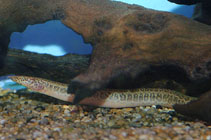| Diagnosis: |
Dorsal spines (total): 24-33; Dorsal soft rays (total): 93-143; Anal soft rays: 90-140; Vertebrae: 95-118. Diagnosis: distance from tip of snout to last externally visible dorsal spine relatively short, 43.2-57.9% SL, decreasing with size (Ref. 57415, 81678). Postanal length relatively long, 44.1-58.3, increasing with size (Ref. 57415, 81678), comparable to or longer than preanal length, 40.0-51.8% SL (m=46.6)(Ref. 57415, 81678). Distance from tip of snout to last externally visible anal spine relatively short, 44.3-57.3 SL, decreasing with size (Ref. 57415, 81678). 1st dorsal spine situated clearly posterior to posterior edge of pectoral fin (Ref. 57415), distance from posterior edge of pectoral fin to origin of first dorsal spine 8.9-89.3% HL (Ref. 57415, 81678). Gill opening small, its distance to dorsal pectoral fin base relatively long, 8.3-14.9% HL (mean 11.5%); 23+1 to 32+1 (median 27+1) dorsal spines (Ref. 81678). Distance from anterior border of snout to first anal spine 42.1-53.5% SL (m=48.2), decreasing with size (Ref. 57415).
Description: generally 2-3, exceptionally 1 or 4, rather small, preopercular spines (median 2); normally 1, rather small, preorbital spine with a tendency to absence of a preorbital spine in larger specimens (Ref. 57415, 81678). 112 mean soft rays in dorsal fin, 110 in anal fin; difference between number of soft dorsal fin rays and number of soft anal fin rays (-8)-(+14) (mean +3)(Ref. 81678). 6-10 caudal fin rays (mean 8); 7-13 predorsal vertebrae (mean 10); 33-41 abdominal vertebrae (mean 36); (0)-(+2) in-between vertebrae (mean 0); 61-78 caudal vertebrae (mean 67)(Ref. 57415, 81678). 103 mean total vertebrae (Ref. 81678).
Coloration: some general intraspecific colour pattern variation and also some geographically related colour pattern variation can be noted (Ref. 57415, 81678). Uniformly light brown overall background colour; dorsal-midline with or without a series of large, dark brown, squared spots or a more or less continuous dark brown band; lateral dark brown band originating at base of rostral appendage, passing through eye, above pectoral fin and continuing along lateral side of body and tail; lateral dark brown band with a well delimited and well contrasted battlement-like upper edge; lower edge less well delimited and gradually becoming lighter ventrally; lower sides with or eventually without several, round, yellowish-white spots; lips, ventral side of head, belly and abdomen uniformly yellowish-white with a few dark brown markings on ventral surface of head; dorsal, caudal and anal fins white of overall background colour; dorsal and anal fin base with a series of dark brown spots eventually partially situated on tail itself; dorsal, caudal and posterior half of anal fin with numerous, additional, small, irregularly displaced, dark brown spots; pectoral fins white of overall background colour and often with no spots or markings; some size-related colour pattern changes, notably a general darkening of median fins with increasing size of specimens; unpaired fins of small specimens with a white overall appearance whereas unpaired fins of large specimens have a dark brown overall appearance however with a white outermost margin; colour pattern of small specimens also characterized by presence of a more or less well defined dark brown band with a highly variable number of, small, yellowish-white spots on lateral sides of body and tail (Ref. 57415). Colour pattern of Akpa Yafe and Ndian basin specimens characterized by a dark brown lateral band originating at base of rostral appendage and continuing posteriorly on lateral sides of body and tail; band with a battlement-like upper edge, well contrasted from lighter brown upper sides and dorsal mid-line; lateral dark brown band, if present in Ntem basin specimens, not sharply demarcated from lighter brown upper sides and dorsal mid-line; unpaired fins whitish in small specimens, darker in large specimens, always with a whitish margin; colour pattern of small specimens also characterized by the presence of a more or less well-defined lateral dark brown band with a highly variable number of small yellowish white spots on sides of body and tail; at least in a few populations (e.g. Ntem basin), there seems to be a tendency for these spots to disappear with increasing size; as a result, large specimens of these populations with only a few, not well-defined, yellowish white spots on their sides (Ref. 81678). |

